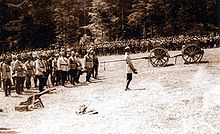
Back Ρουμανική εκστρατεία (Α΄ Παγκόσμιος Πόλεμος) Greek Participarea României în campania anului 1917 Romanian
| Romanian Campaign (1917) | |||||||
|---|---|---|---|---|---|---|---|
| Part of the Romanian Campaign of World War I | |||||||
 Romanian troops at Mărășești | |||||||
| |||||||
| Belligerents | |||||||
|
|
| ||||||
| Commanders and leaders | |||||||
|
High Command: 2nd Army: 1st Army: (until 12 August) (after 12 August) |
| ||||||
| Units involved | |||||||
|
Romania: 1st Army 2nd Army Russia: 4th Army 9th Army |
9th Army Gerok Group | ||||||
| Strength | |||||||
|
Battle of Mărăști (Romanian): 56 battalions 14 squadrons 228 artillery pieces (52 heavy) 21 aircraft Battle of Mărăști (Russian): 3 divisions Battle of Mărășești (Romanian): 78 battalions 58 squadrons 150 batteries (36 heavy) 10 trench mortars 7 anti-aircraft guns 5 air squadrons Battle of Mărășești (Russian): 84 battalions 32 squadrons 79 batteries (9 heavy) |
Battle of Mărăști: 21 battalions 36 squadrons 142 artillery pieces (6 heavy) Battle of Mărășești: 102 battalions 10 squadrons 213 batteries (31 heavy) | ||||||
| Casualties and losses | |||||||
|
Romanian losses at Mărășești: 27,000 |
German losses at Mărășești: 60,000 | ||||||
The Romanian campaign consisted in three battles between late July and early September 1917, fought between Germany and Austria-Hungary on one side versus Romania and Russia on the other. Romania emerged from this campaign with a slight net territorial gain and won its most important battle during the First World War.
The campaign was one of several attacks along the Eastern Front that was launched in support of the Kerensky offensive in Galicia.[1] Its success restored Romania's reputation among the Entente after its defeats in 1916, and was important in developing Romanian national consciousness and increasing morale, becoming the subject of Romanian literature during the Interwar period. However, it only had a small impact on the overall war effort for the Entente.[2]
- ^ Heenan, Louise Erwin (1987). Russian Democracy's Fatal Blunder: The Summer Offensive of 1917. New York: Praeger. pp. 117–124. ISBN 978-0-275-92829-2.
- ^ Torrey, Glenn E. (2011). The Romanian Battlefront in World War I. Lawrence: University of Kansas Press. pp. 253–256. ISBN 978-0-7006-2017-3.